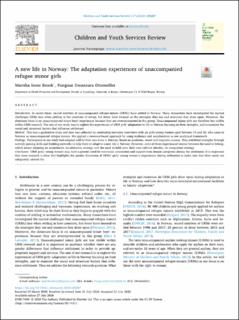| dc.contributor.author | Brook, Martika | |
| dc.contributor.author | Gwanzura Ottemöller, Fungisai Puleng | |
| dc.date.accessioned | 2021-05-05T12:21:39Z | |
| dc.date.available | 2021-05-05T12:21:39Z | |
| dc.date.created | 2020-09-07T16:37:14Z | |
| dc.date.issued | 2020 | |
| dc.Published | Children and Youth Services Review. 2020, 117:105287 1-12. | |
| dc.identifier.issn | 0190-7409 | |
| dc.identifier.uri | https://hdl.handle.net/11250/2753705 | |
| dc.description.abstract | Introduction
In recent times, record numbers of unaccompanied refugee minors (URMs) have settled in Norway. Many researchers have investigated the myriad challenges URMs face when settling in the countries of refuge, but fewer have focused on the strategies they use and resources they draw upon. Moreover, the dominant focus is on unaccompanied minor boys’ experiences because they are overrepresented in this group. Unaccompanied minor girls are therefore less visible within URM research. The aim of our study was to explore the experiences of URM girls’ adaptation to life in Norway focusing on their strengths, and to examine the social and structural factors that influence settlement.
Method
This was a qualitative study and data was collected by conducting narrative interviews with six girls/young women aged between 15 and 20, who came to Norway as unaccompanied refugee minors. We applied a resource-based approach by using resilience and acculturation as our analytical framework.
Findings
Participants in our study had adapted well to their new lives in Norway, based on academic, social and linguistic success. They exhibited strengths through actively gaining skills and building networks to help them to adapt to a new life in Norway. However, some of them experienced tension between the need to belong, which meant adopting an assimilation acculturation strategy and the need to hold onto their own cultural identity, an integration strategy.
Conclusion
URM girls/ young women may have a greater need for emotional connection and support from female caregivers during the settlement. It is important that more research is done that highlights the gender dimension of URMs’ girls/ young women’s experiences during settlement to make sure that their needs are adequately catered for. | en_US |
| dc.language.iso | eng | en_US |
| dc.publisher | Elsevier | en_US |
| dc.rights | Navngivelse 4.0 Internasjonal | * |
| dc.rights.uri | http://creativecommons.org/licenses/by/4.0/deed.no | * |
| dc.title | A new life in Norway: the adaptation experiences of unaccompanied refugee minor girls | en_US |
| dc.type | Journal article | en_US |
| dc.type | Peer reviewed | en_US |
| dc.description.version | publishedVersion | en_US |
| dc.rights.holder | Copyright 2020 The Authors | en_US |
| dc.source.articlenumber | 105287 | en_US |
| cristin.ispublished | true | |
| cristin.fulltext | postprint | |
| cristin.qualitycode | 1 | |
| dc.identifier.doi | 10.1016/j.childyouth.2020.105287 | |
| dc.identifier.cristin | 1827888 | |
| dc.source.journal | Children and Youth Services Review | en_US |
| dc.source.40 | 117:105287 | |
| dc.identifier.citation | Children and Youth Services Review. 2020, 117, 105287 | en_US |
| dc.source.volume | 117 | en_US |

